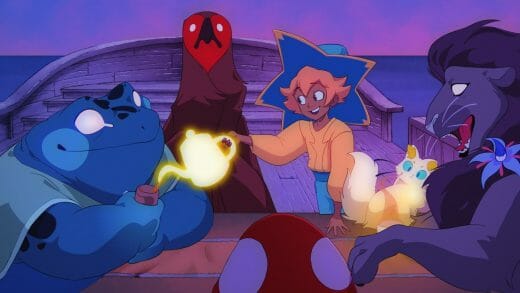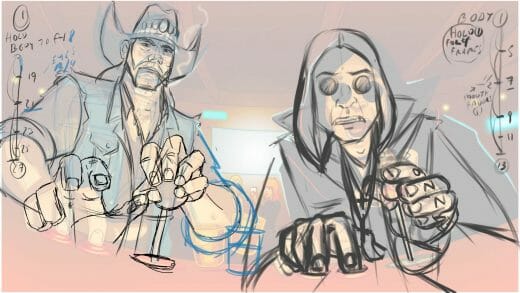
In less than a generation, anime has evolved from a niche Japanese animation style to the country’s main cultural export — creating massive economic boons from television series to tourist attractions like the planned Studio Ghibli theme park. Thanks to the international success of films like Your Name (produced in Toon Boom Storyboard Pro) and demand for original content from streaming services like Amazon Prime and Netflix, the industry had a record-breaking year in 2016, generating over $17.7 billion (¥2.01 trillion) in revenue.
Netflix alone ordered 30 original anime projects for 2018. The medium represented 77 percent of Japan’s television exports in 2016, bringing in $358 million (¥39.35 billion) in revenue — a whopping 36 percent rise over the year prior. With demand for anime surging, Japanese studios are operating at full capacity and many are booked through 2020 according to The Hollywood Reporter.
In order to create high-quality anime at the quantity global audiences want with the efficiency studios need, more Nippon producers are transitioning from traditional pencil-and-paper animation to “tradigital” solutions like Toon Boom Harmony. The software, already the international industry standard, allows for natural hand-drawing and has been adapted to emulate the unique Japanese pipeline and system.
 Source: D’Art Shtajio.
Source: D’Art Shtajio.
Among those making the switch is D’Art Shtajio. The Tokyo-based studio is launching the pilot for XOGenaSYS, its second anime produced in Toon Boom Harmony, this weekend at Anime Expo 2018 to much fanfare and doubtlessly positive attention from distributors, investors and buyers. D’Art Shtajio’s first short created in the software, The Doll, received rave reviews earlier this year*.
XOGenaSYS is based off a manga series by Noir Caesar, a creative agency founded by NBA player Johnny O’Bryant, alongside Nikolas A. Draper-Ivey and writer Tre McIntosh. Set in a dangerous, dystopian future, it follows Darius — a young man who is forced to exchange his art for the arena of the titular violent sport he excels at. With a cast of African-American characters, XOGenaSYS is defying conventions of Japanese anime.
“People have a preconception of what anime is and one of our goals is to break that mould. We want to tell diverse stories that people might not consider for anime. We truly believe that anime is just a medium and that any idea and story can be told through it,” says Arthell S. Isom, founder of D’Art Shtajio.
American-born Isom, who founded D’Art Shtajio in 2016, served as director and writer on the 17-minute XOGenaSYS pilot. He and Noir Caesar hope this will be the first in a 12-episode season. The pilot took five months (nearly 80 percent of which was pre-production) to produce with a team of 30 animators and 20 background artists led by D’Art Shtajio animation director Henry Thurlow.
 Source: D’Art Shtajio.
Source: D’Art Shtajio.
With only a month for actual animation, D’Art Shtajio used a combination of traditional pencil-and-paper and Toon Boom Harmony. The digital solution was used for over half the work, particularly XOGenaSYS’ intense action sequences. On such a tight timeline, Isom notes that the studio benefited massively from Harmony’s ease of use and efficiency in facilitating collaboration and feedback.
“With Harmony, you can see the animation immediately and we were able to make adjustments as needed to character movements. It really sped up production, especially because we were on a time crunch,” says Isom.
When animating traditionally, Japanese studios have to ferry physical paper between artists for feedback. This can take take a day or two when animators (such as freelancers) are not in-house and there’s no guarantee the corrections will be perfect. With Harmony, D’Art Shtajio’s team could make adjustments at the speed of inspiration and innovation. Additionally, animation could be seen and tested with the push of a play button — no need to flip any paper.
 Source: D’Art Shtajio.
Source: D’Art Shtajio.
“Japan is definitely moving towards becoming a tradigital country. It’s taking time, but they are shifting. Once they make the move to programs like Toon Boom Harmony, it’ll make production a lot easier and faster,” says Isom.
He continues, “With all these streaming services, there has never been more demand for anime. The only way to meet that demand is tradigitally. The small stoppages in time [in traditional anime] only inhibit the industry.”
D’Art Shtajio is leading the change by focusing on becoming a fully tradigital studio. Fortunately for its artists, Toon Boom Harmony has been tailored to the unique needs of Japanese animators, from checks-and-balances to check points to time sheets.
 Source: D’Art Shtajio.
Source: D’Art Shtajio.
Having successfully completed two projects now in Toon Boom Harmony, D’Art Shtajio’s work speaks for itself — and is spreading the word to other Japanese anime studios.
“Our technical director, Tatsuji Yamasaki, has been in the industry for over 40 years and was really impressed with how Harmony worked. He thought it was amazing how he could see the animation right away and wanted to share it with the other artists he works with,” says Isom.
“We’ve had that experience a lot with Japanese animators who come in and we teach to use the software. The ease of use, creative results and features that are super convenient —like being able to change the colour in all frames at once if there’s an error— are exactly what the industry here is looking for and needs to keep moving forward.”
* Editor’s note: Read about D’Art Shtajio’s journey producing The Doll with Toon Boom Storyboard Pro and Harmony on “Cartoon Brew”.



